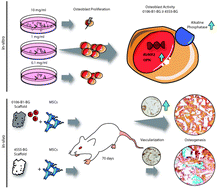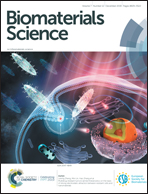Favorable angiogenic properties of the borosilicate bioactive glass 0106-B1 result in enhanced in vivo osteoid formation compared to 45S5 Bioglass
Abstract
The 45S5-bioactive glass (BG) composition is the most commonly investigated amongst BG-based bone substitutes. By changing BG compositions and by addition of therapeutically active ions such as boron, the biological features of BGs can be tailored towards specific needs and possible drawbacks can be overcome. The borosilicate glass 0106-B1 (composition in wt%: 37.5 SiO2, 22.6 CaO, 5.9 Na2O, 4.0 P2O5, 12.0 K2O, 5.5 MgO, 12.5 B2O3) has demonstrated pro-angiogenic properties. However, the osteogenic performance of the 0106-B1-BG and its influence on cell viability and proliferation in vitro as well as its osteogenic and angiogenic properties in vivo have not been investigated. Therefore, in this study, the impact of 0106-B1-BG and 45S5-BG on osteogenic differentiation, viability and proliferation on human mesenchymal stromal cells (MSCs) was assessed in vitro. Furthermore, MSC-seeded scaffolds made from both BG types were implanted subcutaneously in immunodeficient mice for 10 weeks. Osteoid formation was quantified by histomorphometry, vascularization was visualized by immunohistological staining. Additionally, the in vivo expression patterns of genes correlating with osteogenesis and angiogenesis were analyzed. In vitro, the impact of 45S5-BG and 0106-B1-BG on the proliferation, viability and osteogenic differentiation of MSCs was comparable. In vivo, scaffolds made from 0106-B1-BG significantly outperformed the 45S5-BG-based scaffolds regarding the amount and maturation of the osteoid. Furthermore, 0106-B1-BG-based scaffolds showed significantly increased angiogenic gene expression patterns. In conclusion, the beneficial angiogenic properties of 0106-B1-BG result in improved osteogenic properties in vivo, making the 0106-B1-BG a promising candidate for further investigation, e.g. in a bone defect model.



 Please wait while we load your content...
Please wait while we load your content...